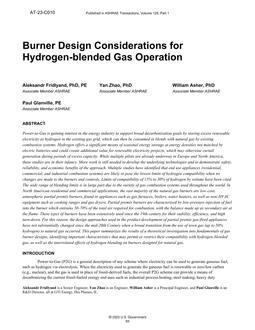Click here to purchase
Power-to-Gas is gaining interest in the energy industry to support broad decarbonization goals by storing excess renewable electricity as hydrogen in the existing gas grid, which can then be consumed in blends with natural gas by existing combustion systems. Hydrogen offers a significant means of seasonal energy storage at energy densities not matched by electric batteries and could create additional value for renewable electricity projects, which may otherwise curtail generation during periods of excess capacity. While multiple pilots are already underway in Europe and North America, these studies are in their infancy. More work is still needed to develop the underlying technologies and to demonstrate safety, reliability, and economic benefits of the approach. Multiple studies have identified that end use appliances (residential, commercial, and industrial combustion systems) are likely to pose the lowest limits of hydrogen compatibility when no changes are made to the burners and controls. Limits of compatibility of 15% to 30% of hydrogen by volume have been cited. The wide range of blending limits is in large part due to the variety of gas combustion systems used throughout the world. In North American residential and commercial applications, the vast majority of the natural gas burners are low-cost, atmospheric partial premix burners, found in appliances such as gas furnaces, boilers, water heaters, as well as non-HVAC equipment such as cooking ranges and gas dryers. Partial premix burners are characterized by low-pressure injection of fuel into the burner which entrains 50-70% of the total air required for combustion, with the balance made up as secondary air at the flame. These types of burners have been extensively used since the 19th century for their stability, efficiency, and high turn-down. For this reason, the design approaches used in the product development of partial premix gas-fired appliances have not substantially changed since the mid-20th Century when a broad transition from the use of town gas (up to 50% hydrogen) to natural gas occurred. This paper summarizes the results of a theoretical investigation into fundamentals of gas burner designs, identifying important characteristics that may permit or restrict their compatibility with hydrogen-blended gas, as well as the interrelated effects of hydrogen blending on burners designed for natural gas.
Product Details
- Published:
- 2023
- Number of Pages:
- 9
- Units of Measure:
- Dual
- File Size:
- 1 file , 5 MB
- Product Code(s):
- D-AT-23-C010
- Note:
- This product is unavailable in Russia, Belarus
